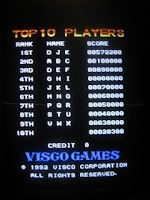If you hadn't noticed by now, I'm a huge NMK fan, and this PCB had occupied the number 1 slot of my most wanted list for the last 3 years! What most consider the pinnacle of NMK's vertical shooters, is also the most rare, so words can't express how happy I am to now have this in my collection. ^_^
[Update 08/31/13]
Earlier this year, a Korean / International version of Rapid Hero was discovered called Arcadia. As with other Korean region games, these have notably different colored silk-screening and components (typically cheaper to save costs). System11 over at shmups forum has broken down the general difference between regions as follows:
Japanese build NMK pcb:
- Amp screwed down to the PCB
- Small filter caps near all TTL chips
- Typical paper square NMK ROM labels
- Typical paper NMK serial sticker (obviously these are often missing)
- Mostly Japanese brand TTL chips - Motorola everywhere
Korean built NMK pcb:
- Amp just floating - typical assembly method for Korean and bootleg games
- Mitsubishi ROM labels - again common in Korea
- Incorrect large filter cap sizes - back in the day cheaper brands were often larger
- Most of the small filters are missing (a cost cutting measure, extrremely common on Korean boards of all makes)
- Masses of Goldstar chips - while you do see isolated use on some Japanese boards, it's normal for Korean boards to be covered with them.
There has been at least one occurrence of a Korean built Arcadia board surfacing with Rapid Hero roms covered with Mitsubishi stickers. Its unclear if this was a rom-swap by Korean importers, or are original JP roms populated by Korean distributors. I've included some examples of recent sales, the last one being the board with RH roms.
 Arcadia sold on eBay for $611 by boardfixxer (Korean importer) on Jun 03, 2013
Arcadia sold on eBay for $611 by boardfixxer (Korean importer) on Jun 03, 2013 Arcadia sold on eBay for $999 by www_worldhobbyist_com for $999 (Korean importer) on Aug 13, 2013
Arcadia sold on eBay for $999 by www_worldhobbyist_com for $999 (Korean importer) on Aug 13, 2013 Aracdia with Rapid Hero roms on shmups forum sold for (unknown amt) by snkpowa on Jul 13, 2013 and then again for €460 by warlord on Aug 31, 2013
Aracdia with Rapid Hero roms on shmups forum sold for (unknown amt) by snkpowa on Jul 13, 2013 and then again for €460 by warlord on Aug 31, 2013Arcadia unsold on ebay for $999 by by boardfixxer (Korean importer) on May 30, 2015
[Update 08/28/19]
So it turns out one of my friends recently bought a Rapid Hero board, which is a pretty rare find nowadays. Upon looking at the picture, it was clear the board was actually an Arcadia that had been rom swapped to Rapid Hero. All the tell tail signs were there, as described above, in fact upon closer inspection, the board he bought (in late 2019) was actually the 2nd board I have pictured above that sold on eBay Aug 13th 2013! Lets take a closer look at his board:
First off, the pea green colored silkscreened top board is a dead giveaway of an Arcadia. Then there is the floating amp, black caps, and goldstar chips. What has changed is removing of the Korean tax sticker across the mask roms, and of course newly burned roms with fake labels (which were pretty well done).
So how do we know for sure this is the same as the 2013 Arcadia on eBay? Look closely at the mask roms where the tax sticker was removed. Notice the scraps along the bottom right most mask rom. Also notice the same irregularities around the jamma edge. And finally if you look at the first SMT chip below the jamma edge, again you will see a similar scrape along the right and left on the chip.
So yes, people are trying to pass off Korean Arcadia's as Japan Rapid Hero's, and going to great lengths to do so. Now why would someone do this? I'm sure the Korean version is just as rare, and in my opinion just as valuable. But to the otaku PCB collector, they will pay much more money for an authentic Japan region board than the same game made for international distribution. This is what creates demand for these types of conversion shenanigans.
Five year bump since last update (14 years since original post)! Another Rapid Hero appears on eBay, this time by a well known China seller (who happens to also sell cave cv1K bootlegs). But this one looks to be legit. Both PCBs have the correct JPN color and components. The unlabeled program rom is not unusual, mine also came that way from a Japanese operator. Of course prices have come a long way in 10 years on eBay. The seller is w45050 and the listing price is $6000! I'll have to update this again, if it sells, but likely with offers turned on, we won't know know it actually sells for.


































































